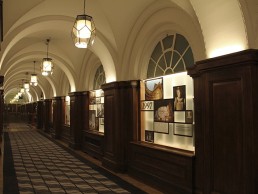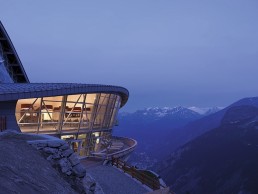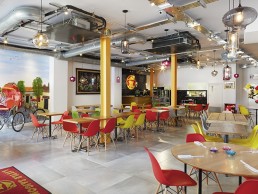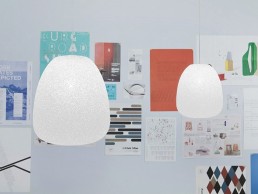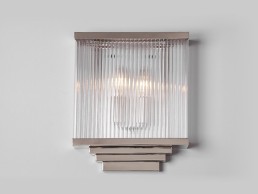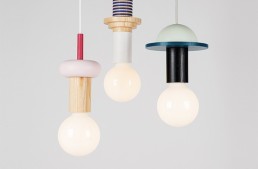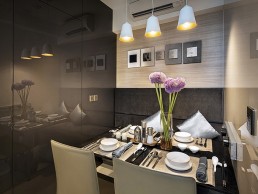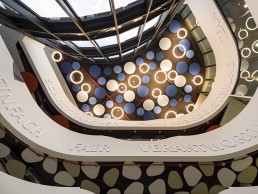Southbank Place residential, UK
In preparation for the opening of Southbank's newest residential development, DesignPlusLight worked with Goddard Littlefair to produce a high-end, luxury lighting scheme for the Grade II listed marketing suite in the Country Hall building, communicating the quality of the final development.
Southbank Place is London’s newest exciting riverside development by Canary Wharf Group and Qatari Diar Real Estate Investment Company. Scheduled for completion in 2019, it combines architectural excellence with an iconic setting to create some of the most sophisticated homes on offer in central London. The mix-use development is situated opposite the London Eye, with exceptional views across the river Thames to Whitehall.
DesignPlusLight (DPL) worked in conjunction with interior designer Goddard Littlefair to light the rooms of the Grade II listed marketing suite in the County Hall building, adjacent to Westminster bridge, in the former private offices of the GLC and the headquarters for The Diana, Princess of Wales Memorial Fund.
Steeped in British history, DPL was briefed by interior designers Goddard Littlefair to design a bespoke architectural lighting scheme with the level of luxury and finesse that would instantly communicate the quality of the finishes in the final development.
DPL created a high end, luxury lighting scheme to enhance the journey and seamlessly connect the entrance reception, through to the meeting rooms, display pods and finally into the sample suites. The heritage-listed building was brought back to its original state and new features were added that would seamlessly integrate with the historic fabric of the building.
“Our whole design ethos is to create layers of light that collectively enhance the perception of space and communicate an instant feel of exclusivity,” said DPL Project Director Sanjit Bahra. “Good lighting should always complement, but never take precedence over the interior design. We were extremely mindful of the heritage elements of the building from the outset, and this proved to be one of the most challenging aspects of the project. By working closely with the site engineers and design team, we were able to find creative solutions to illuminate each space.”
DPL stressed the importance of using an architectural lighting control system on the entire project so that all the lighting elements could be carefully balanced to create mood settings. Given the nature of the building installing mood lighting was a challenge as not all of the cable routes in such an old building were known. DPL proposed a wireless control system by Rako Lighting that enabled the existing wiring to be utilised and expanded upon to create multiple circuits within each room.
Lighting was integrated into joinery pieces to bring layers of light into each space. Careful attention was made to keep each element unique to enhance the journey through the marketing suite. As artwork was a passion for the client, the joinery elements created the perfect lighting display opportunity.
Goddard Littlefair refurbished the entrance reception to give immediate sparkle and glamour to the space, with existing ceiling points reused and the fluorescent bulkheads replaced with bespoke decorative chandeliers, which were specially designed by the interior design company with advice from DPL.
A new reception desk was designed with vertical lines of LED light carefully detailed within the metal folds, offering a glimpse of the structure within, while discrete surface spotlights concealed within the ceiling coffers provide a focus onto the stone fireplace and clock. The window treatments of sheers and curtains were highlighted with a halo of light emanating from the head of the pelmet, softly lighting the display plinths below.
In the stairwell, a bespoke 6m crystal chandelier from Preciosa Lighting, designed and commissioned by Goddard Littlefair, emphatically draws the visitor up towards the first floor, while sixteen interlinking rings of light, supported from five storeys above, cascade down the central stairwell, sparking and shimmering as guests ascend. The existing fluorescent landing bulkheads were covered with parchment shades to soften their appearance and to provide a warm domestic like light.
DPL created a sense of arrival on the first floor landing by up-lighting the arch reveal above the door header and illuminating specialist eglomisée panels either side. These reflected the light from the chandelier to provide further sparkle.
On arrival, visitors are taken into the reception room where they are welcomed and shown brochures of the development. A stunning chandelier anchors the visual attention to the centre whilst custom designed cabinet pieces frame the four corners of the room. These have a multi-purpose function, serving both as display pieces as well as housing the heating and air-conditioning mechanics required for the space. DPL worked closely with the interior designer to integrate a flush line of light to frame each cabinet. Individual display recesses were lit with under shelf lights. LED up-lights were concealed in the top of the cabinets to provide reflected light into the space. Subsequently only a few surface spots were required to light key artwork pieces.
“The central chandelier should never provide more than a decorative glow, so it’s particularly important, in listed buildings, to consider how to bring light into the space,” commented Bahra.
A boardroom features a stunning custom created black raindrop chandelier by Tom Dixon, which hangs down from the ceiling with the perfect balance in tandem with the bespoke joinery pieces. The showroom also features two closing rooms to represent the height of luxury and finesse within the new residential project. Both rooms feature custom designed chandeliers with surface spotlights carefully concealed adjacent to the chandelier rose to light the fireplace and artwork. Smaller cabinets were designed as drinks cabinets, beautifully lit with concealed LED strip lights that provide a warm reflected light into the space.
The second closing room is the grandest room in the suite and serves as a representation of the later phase of the development. The high bay window offers a magnificent aspect of Big Ben and is perfectly framed with curtains, softly lit with LED strip-lights concealed behind the pelmet. Plug-in up lights illuminate the fireplace surround whilst the occasional surface spotlight illuminates key artwork pieces.
An integrated corridor links the U-shaped 1,207sq.m suite rooms. The original timber panelling within the corridor was removed and meticulously restored, giving DPL the ideal opportunity to bring cables up the walls without damaging the fabric of the building. LED striplights were concealed to the top of the pilasters to up-light the vaulted arches and create a sense of rhythm along each corridor. At each junction, mini LED spotlights were concealed behind specially made plaster mouldings to highlight the cross vaults and punctuate the end of each corridor. The existing fluorescent pendants that were once the sole form of lighting within the space were replaced with decorative glass and parchment lanterns. These could not be dimmed, as they were the emergency lights to the space, so DPL recommended low energy LED candle lamps that enhance the room with a soft glow.
A series of exhibition rooms overlook the Thames, where potential buyers can view the individual elements of the development with scale models and information panels.DPL's work with Goddard Littlefair works to give potential clients an idea of what the final residential project will encompass. The lighting ighting approach was kept consistent to ensure a sense of continuity across the exhibition space.
Charles Lethaby Lighting Elara
Elara is a timeless and compelling golden star of light - and one of Charles Lethaby Lighting’s flagship designs. Its 40 identical arms are each screwed into a central body, which also houses two rod filament lamps. Available in solid brass or anodised aluminium, Elara comes packaged in a luxury black tube.
www.charleslethabylighting.com
Skyway Monte Bianco, Italy
Inaugurated in June 2015, leading Italian design and general contracting company Paolo Castelli decked out the new Mont Blanc cable car stations, Skyway Monte Bianco. With a modern and majestic flair, the interiors of each station feature striking lighting schemes designed by architects Roberto Rosset and Danilo Montovert. Unique in dimension and complexity, the three stations stand at increasing altitudes, each structure marking a technologically advanced expression of the classic ‘Made in Italy’ slogan.
Having begun in 2012 with the installation of the ropeways and basic structures, Skyway Monte Bianco was a long journey to the peak. With no indication from the client in terms of lighting design, Architects were given free reign in choosing the lighting “based on the interior decoration and furnishings specified in each setting along the ropeway,” commented Rosset. “The goal was simply to create a specific and unique atmosphere for each room in keeping with the interior decoration.”
The funicular ascent of Mont Blanc begins at the first station, Pontal d’Entrève, where visitors can start their journey in style at a sleek bar, mixing a few drinks in with the steadily increasing altitude. With a curved metal ceiling high above the bar, tossB’s slender HOOP 950 pendants are suspended half way, emitting a clean white light reminiscent of the surrounding white crystal in cloud and snow. Ensuring bright lighting for both the bar area and the ceiling, the lighting stands at a sharp juxtaposition to the wood, steel and ceramic panels, creating a mix of materials that evoke the magnificent surrounding mountain range.
Becoming increasingly more light headed as the altitude kicks in, visitors can carry on to second stop along the ascent to Europe’s peak, The Bellevue Restaurant at the 2,173-metre high Pavillion Station, featuring a casual dining and relaxation area. A modern reinterpretation of a dining space commonly associated with the traditional use of local wood as a finishing material again creates a conversation with the grand surroundings, letting the lighting steal the interior show. Luceplan brings the interior space to life with Silenzio pendants suspended above each table in oversized jolts of orange fabric. In another contrast, albeit secondary to the lighting scheme as a whole, Viabizzuno’s c2 rotante wall lamps designed by Italian lighting designer Mario Nanni stand on the white walls, adding a seemingly unnatural colour in contrast to the earthly surroundings, emphasising this modern feat that works alongside tradition and nature.
The final stop, the peak of the cable car journey at 3,462-metres high, houses the Punta Helbronner; an angular yet soft space to sit and admire the awe-inspiring surroundings. Here, daylight is given the spotlight, with no shortage nor competition in such panoramic glory. Those brave enough can step out onto the Helbronner roof to immerse their heads in the clouds in what is surely heaven on earth.
“The project was a challenge,” admitted Managing Director Paolo Castelli, “and not just because of the complications associated with working at an altitude of 3,500-metres. Our designers, engineers and architects have succeeded in expertly and accurately developing Arch. Rosset and Montovert's projects, creating settings that are both convivial and refined, achieving a perfect union with their majestic natural surroundings. Establishing a decorative and architectural dialogue with the beauty of the Mont Blanc was no easy matter.”
The balance achieved in this project is one of expertise and passion; interior natural tones draw the mountains into each station while the lighting serves to make each space stand out in its own right, affirming the modernity of the project while respecting its natural scale. Bringing lovers of nature’s grandeur to the highest of Europe’s heights, the journey along Skyway Monte Bianco is undoubtedly the pinnacle of funicular journeys.
Image credit: Daniele Domenicali
Little Saigon, Vietnam
Little Saigon hits the nail on the head with street food as a family owned restaurant that immerses guests in traditional Vietnamese culture, illuminated with a contemporary twist.
Bringing authentic Vietnamese street-food to a discerning East London crowd, Little Saigon is a brand new 100-seater family owned restaurant based in one of London’s most vibrant areas. With a dream to bring their family’s cooking to a wider audience, the Pham family opened their debut Leytonstone restaurant in May 2015.
With London-based interior design studio Avocado Sweets' expertise, lead by designer Evros Agathou, the restaurant now appeals to the local London market, capturing a casual street-food vibe while maintaining a strong link to the Vietnamese family’s cultural traditions. Street-food in Vietnam is a laid-back affair with friends, served at low-level tables on the street outside a restaurant. To create the right pared-back atmosphere indoors for Little Saigon, the building was stripped back to its original shell to start afresh.
“We installed exposed steel ventilation ducting on the ceiling, and painted the steel support beams and an original brick wall in pastel colours,” said Agathou. “Using these bare bones as a base, we built the design layering colour and texture to the building’s structure in order to create a pared-back, yet playful and stimulating interior.”
The lighting was a crucial part of giving the design an individual yet authentic feel. New York-based lighting brand Niche Modern’s smoky glass pendants from the Edison Industrial range, were selected, speckled throughout in a range of shapes and pastel colours echoing the paper lanterns found in Vietnam, giving an original twist to the well-known look. A dynamic playfulness was injected by adding colour to the varying textures of the building’s structure, a theme reflected in the lighting products used. Further to this, light modern chairs and an original wall mural add to the playful and creative feel of the laidback restaurant.
Meanwhile, vintage tables provide an earthy quality to the seating, exposing the raw of tradition of Vietnamese culture, with vibrant pieces of art depicting scenes from Vietnamese life. An open window into the kitchen provides tantalising glimpses of activity, while being careful not to overwhelm the space. A selection of low-level tables and chairs are on offer for those who want to experience their food in the truly traditional Vietnamese style.
As the Pham family’s first venture in food, Little Saigon has proved a success with queues outside the door from day one. Owner Robert Pham commented on the family’s collaboration with the interior designer: “We have been very impressed with Evros’ ability to deliver an identity that perfectly symbolises our thoughts and vision, conveying the stylish and modern image we were seeking. He made it personal. It’s brilliant to have someone feel and understand what we felt, and to transform that feeling into an amazing interior.”
With Niche Modern’s trinkets of light echoing the low glow of Vietnamese street dining, Little Saigon brings home the comfort and colourful flavour of South East Asian cuisine, letting everyone experience the traditional Pham-ily flavour.
Image credit: Andrew Beasley
Zava Andromeda
Designed by Italian designer Paolo Ulian, the Andromeda light fixture is composed of shifting polygonal-shaped pieces that appear to come together and pull apart all at once. It casts an artful scattering of light and shadows that bring to mind playful organic forms.
Lumen Centre Italia Sumo
Inspired by the strong body of a Japanese wrestler, the Sumo collection is a family of lamps that includes pendant, wall, ceiling and floor lamps in several sizes. Each lamp diffuser is made of micro pierced self extinguishable polycarbonate, with a powder coated white metal frame.
Pantinas Hamburg
The Patinas Hamburg wall lamp is handmade in Hungary. Made of solid brass and available in different finishes such as antique,shiny brass,nickel, the lights can be customised to suit the client. The sockets are made of porcelain allowing for the use of traditional, energy saving lamps and LEDs.
Schneid Junit Lighting
A modular pendant lamp that consists of eight different elements. Available in a natural, clear finish or in different colours, the lamp complements the colours with its oversized milky glass that produces warm, ambient light. Eight different texile cable colours are also available.
Jette Scheib
Remembered through a drab and desolate filter, East Berlin has never been known to nurture the creative heart. German designer Jette Scheib started out on the East side, born in 1977 in a small pocket of artistry nestled deep within the regime. Scheib’s mother is a costume and stage designer and her father Hans Scheib an artist, now internationally renowned for his stylised, sculptural works.
darc magazine’s Femke Gow talks to Scheib about all things inspiring and enticing along her journey into the world of light, from how she entered the world of design to how she has now found herself designing for Innermost.
When did you first realise you wanted a career in design?
My mother was always building stage models for theatre plays and my father was always working with wood, graphics, and drawing a lot. We really didn’t have much money, so I had to be creative. I had a Barbie doll, and she needed clothes and a house, so for me, that was the fun part. My mother would make clothes for my doll, and I could make things for her out of whatever materials I could find around the house. For me, the playing was the making. I think that’s where it began, in East Berlin. We left for the West in 1984, five years before the wall came down.
What kind of jobs did you have before entering the world of design?
Well, after a disastrous stint working as a waitress, I worked in a felt design shop. I later taught at the Berlin University of Arts as an artistic co-worker under my old professor. It was really great and interesting to work with students, with all of this creative potential looking for the right direction to express itself. They learned from our experience but I also learned a lot from them.
Who were your main influences starting out?
That would probably be my parents. I used to go to the zoo with my dad to watch and draw animals. Later I wanted to become an artist myself. This was difficult though because people could see the influence of my father in my drawings or sculptures. I didn’t want to always be in the shadow of my father, so I had to find a different way to live my creativity. I applied to study design.
Aside from roots, everything has an influence on the creative process. You grab things with your senses and it keeps working on your brain without you even knowing. I also love scrolling through Pinterest. You can really get into a mood and it’s like taking a walk through a design world.
I am in love with designs, not designers. For example, Arik Levy’s Wire Flow is one of those magical designs for me. It’s a lampshade created out of technical supplies. It’s graphically strong, and he really made something out of nothing, and that is just…wow!
So what is it about lighting that appeals to you from a design perspective?
Light itself is fascinating. You can have the nicest furniture, the softest couch, but if the light is not right, if it is not presented in the right light, then you won’t sit comfortably. Light makes a room; the shade around the light, how it is presented, the material that shines through it. Light brings a room together.
Do you have a signature style?
I like to question the order of things; take a look at clichés and habits. This is what I also intended to do with the Membrane for Innermost. Usually there is a fragile lamp a shade to protect it. With the Membrane, the shade is independent, a fragile being that is attacked by three lamps that conquer the shade. I wanted to give both parts a different character and part to play, so the typical order of a lamp is reversed. I’ve also heard that people think it looks a bit like fertilisation … so you can also see it like that if you want. Light is life and without light, there is no life.
Tell me a bit about one of your most notable projects.
During the last few years I have been designing mostly for gift and home accessory companies, so I am quite new to the world of lighting design, even though I have always been fascinated by it.
One of my most notable projects besides the Membrane is probably the “wine light”, which I designed for a German homeware company called sidebyside. It is a tea light holder made out of a wine bottle top with a wooden base. That was one of my first successful experiences working with light, and still is a very successful product.
The Membrane is your first big lighting project. How did your collaboration with Innermost come about?
We met at a trade fair years ago, when I was still doing collaborative designs with a friend. I had recently made a lamp out of lasercut pp-foil that buyers could put together themselves, but that wasn’t very popular… apparently people want to open their products to find a finished piece.
So at the time I was talking to Steve Jones from Innermost, who is a really great guy and I knew I wanted to work with him at some point. So I approached him with my idea for the Membrane and he liked it.
What I really liked about working with Innermost is that they are simply in love with good ideas. They dare to not only work with the big names; they trust their own judgement in designs and they believe in smart, thoughtful creativity.
The Membrane presented a challenge and it took quite a while with physical glass blowing, which I have no experience in, and a lot of trial and error from all of us. The glass ‘egg’ looked a bit wobbly in the beginning but we all communicated a lot and it gradually became more and more rotund. Innermost did a really great job with product development.
Designers can have really great ideas but when put in the wrong hands, it can turn out so horrible. But this didn’t happen with Innermost – it was a really collaborative and communicative effort. They took this project very seriously and every technical and aesthetic detail was well thought out and elaborated.
As you’re new to the world of lighting deisgn, what kind of trends are you seeing and where do you see things going?
I see a lot of geometric shapes in bright colours, wire construction and traditional materials; metal, glass, stone, wood – these materials have honesty, and wealth. It is like a more colourful Bauhaus style of 20th century modernism that brought creativity and the beauty of manufacturing together.
Of course for every movement there is an opposite movement, so I think organic shapes and softer materials will have a come back too. It has already started with the whole Macramé hype of knitting combined with industrial styles.
Any idea what we can expect to see from you next, Jette?
If only I knew! Membrane was exciting and it made me hungry for more. I’m curious what life will bring me, where it takes me and what I will produce. It has given my work a new focus and puts me in a new light, which is great.
Spottiswoode Residence, Singapore
A small space is not always a limitation; Flair Illume saw the restriction as a creative opportunity to use light in developing an intelligently thought out Singapore home.
Lighting company Flair Illume in Singapore developed a futuristic interior with a thoughtful lighting scheme, making use of Innermost products for the Spottiswoode Residence. Managed by Flair Illume Product Specialist Ian Tan, who has a strong foundation in the interior design sector for providing functional, aesthetic and revolutionary lighting solutions, Flair Illume was able to meet the client’s brief of using light to create irregularity, while meeting the purposes of different spaces.
Drawn to Spottiswoode for its intelligent space planning, the client's interior designer Sabrina Ang had transformed this small, compact and double volume ceiling height space into a luxury furnished residence, where office and home could be integrated. Tan explained how light was used across this space: “The initial concept was to use different light fixtures to create a futuristic feel for the designed space, with a functional yet decorative appearance, where illumination is sufficient for dining, working and presentation.”
Light enhances spatial design and effects emotion; “without light, all is darkness,” said Tan, who holds close to his designs the idea of healthy lighting. In developing the scheme for Spottiswoode, Tan focused on the notion that the human body uses protective measures against lights that are too bright or too hot. Natural aversion from bright lights creates discomfort, which is a danger “when lights are not properly designed.”
The space within the house was divided up, each with its own purpose, yet with a uniform light colour temperature throughout to create a sense of unity. The double volume space uses Innermost’s Buckle pendant light to create an ambient light sculpture, making use of a mirror to make the smaller space appear larger. The irregular shape of Innermost Buckle pendant lights, one at a 70cm diameter, and the other at 120mm, is the key to the futuristic style of this interior scheme. “Neither too bright nor dim, Buckle scatters light around creating background lighting for the space, rather than using harsh lights directed straight down from the ceiling," said Tan. "As for the Circus pendant lamp, it illuminates the dining area in a gentle atmosphere, while projecting sufficient light for the surrounding working areas.”
The team faced a challenge in mounting Buckle at the double volume ceiling height. Tan explained how working with a residential project, they were restricted by space: “By wiggling through the narrow space and getting the centre portion clear, we could lay the pendant down. Scaffolding was then erected to put the two Buckle pendants up.” While most commercial spaces have more room to work with, “all designs are about looking at the space available and allocating appropriate products based on applications and requirements, so a different approach is necessary for every application.”
Through thoughtful design and intelligent allocation of space, light has been used enhance Spottiswoode, showing that the right materials, beautiful lighting fixtures and a good imagination are all that is needed to bring luxury and comfort together.
Lladro Mademoiselle
The Mademoiselle collection from Lladro features colourful lighting designs including pendant and table models as well as spectacular chandeliers. The translucent porcelain of the lamps projects the decorative hand etched pattern creating a warm light around the room.
TeamBank HQ, Germany
Swiss architecture and design studio Evolution Design provided a different way of working for leading German consumer credit expert TeamBank, with a new HQ for its main brand easyCredit in Nuremberg.
The building itself was the result of a design competition, created by Austrian architecture firm Baumschlager Eberle and executed by Nuremberg architects GP Wirth Architekten. Aiming to reflect openness, transparency and communication, the pioneering design brief for the competition was already in line with easyCredit’s values. Evolution Design developed an interior design scheme to converse with the building’s large open-space work areas, placing great importance on expressing TeamBank’s easyCredit brand philosophy: an agile, constructive approach to the work environment that clearly expresses easyCredit’s claim of being a leading innovator and trendsetter in the banking sector of Germany.
Upon entering the atrium, the 700+ employees are met with a spacious, high-ceilinged area in which the divisions between each floor can be seen when looking up. The building features floor to ceiling windowed structures, letting an abundance of daylight wash through each level. Lightnet’s Ringo Starr pendant lamps glow in rings on the ceiling amongst blue and beige circular fixtures that span across the top floor.
The functional organisation of the building’s interior utilises the idea of a city; the building was divided into Homezones consisting of several Homebases and Meet & Create zones, with a main staff restaurant and barista bar. These public areas are part of the city concept with parks and street scenes to encourage a higher frequency of informal and accidental meetings.
Evolution Design's biggest challenge was the change from a traditional workspace with dedicated desks to a completely new activity-based style of working. Each Homebase consists of a unique mixture of different workspace typologies to cater for the different needs of employees depending on their daily activities. The Meet & Create zones are specially designed in the inner ring of the building for creativity and focus. One of the informal Homebase areas, which are spread over the first and second floors, seats employees at high, gleaming white tables on stools under the illumination of Lasfera’s soft plywood Sophie pendants, giving off a gentle glow. The space is practically suitable for work without being corporate.
Employees of TeamBank can even spend their working days swinging back and forth on a suspended cushioned bench in the Green Lounge. David Trubridge’s Coral pendants complement the natural theme of this space, as the use of wood casts a soft shadow in the fragmented shapes of the lamp's design.
As well as the profusion of leisurely spaces, even this office needs more traditional meeting rooms to cater for the more regulated moments. Nevertheless, they are not just standard meeting rooms, as Lightnet’s Amorphicon pendants immediately cast a playful tone around one of the meeting rooms on the third floor. Their white light marks clearly their bulbous outlines, reminding staff of their innovative and inspiring physical environment, while aiming to instill those properties mentally and in conversation. Another meeting room on the ground floor, interchangeable as a lounge, features Marset's playful TamTam pendants suspended in clusters.
Designed for TeamBank employees to collaboratively exchange ideas is the Project Room on the first floor, featuring a long wooden table with industrial metal legs, whiteboards on wheels and a projector. Above this high table, Moooi’s Dear Ingo pendant lamp designed by Israeli designer Ron Gilad sits on the line between abstract and functional. With fifteen spider like arms stemming from its main body, it works perfectly for a large group as each arm can be extended and directed out to different points at varying angles.
Throughout the building, all spaces have been designed to bring the company’s culture and vision alive, thereby realising TeamBank’s identity and the easyCredit brand. The result is a building in which easyCredit and its employees can find an inspiring home that reflects their company spirit and enables them to identify strongly with their new workplace and headquarters in which they can share their values of fairness, teamwork and communication. The new easyCredit headquarters successfully brings together a new workplace concept while strongly expressing the company’s identity through physical structure and thoughtful design.

